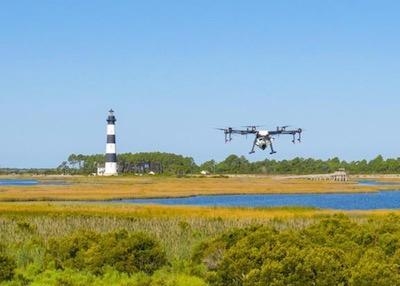Mon, Oct 07, 2019
Combatting Non-Native Species Around Bodie Island Lighthouse
The N.C. Department of Transportation's Division of Aviation and its Environmental Analysis Unit have teamed up to fight invasive plants with a new tool: drones.

The area around Bodie Island Lighthouse was overrun with Phragmites, a type of aggressive, non-native marsh grass that pushes out all native species. NCDOT was responsible for combating the invasive plant as part of its environmental mitigation for the construction of the new Basnight Bridge over Oregon Inlet. The NCDOT Environmental Analysis Unit turned to the Division of Aviation to help explore the use of drones as an alternative to traditional airplane- or helicopter-based herbicide spraying.
The project, which recently wrapped up for the 2019 season, found that drones provide a more targeted and efficient spray operation than traditional methods. Drones use less of the herbicidal spray, as they can be programmed to target a specific area and flown safely at low altitudes to reduce the amount of herbicide blown away by wind. They can also be outfitted with cameras that allow officials to monitor areas without having to step through potentially dangerous terrain or disturbing other plant and animal life.
“The drone has minimal impact on the surrounding area," said Morgan Weatherford, environmental modeling team lead with the NCDOT Environmental Analysis Unit. “It was easier to avoid harming native species, better targeted, and quick to mobilize - great for somewhere with unpredictable weather like on the Outer Banks."
Drones are also safer and more cost effective than manned aircraft for these types of operations because they eliminate the need for plane and helicopter pilots to fly low while applying the herbicide. Additionally, in the case of popular tourist sites like Bodie Island Lighthouse, the area doesn't need to be closed to the public while operations are taking place.
“This was a one-of-a-kind partnership, and the first time a drone had ever been used for herbicide spraying on National Park Service land," added Weatherford. “We plan to continue and expand our drone program in the future."
(Image provided with NCDOT news release)
More News
Also: Horizon Picks P&W PT6A, Army Buys 3 EagleNXT, First Hybrid-Electric Regional, Army Selects AEVEX Anduril Industries’ YFQ-44A Collaborative Combat Aircraft was flown>[...]
While Flying North Along The Beach At About 300 Ft Above Ground Level, The Pilot Reported That The Engine RPM Dropped To About Idle On September 28, 2025, at 1126 eastern daylight >[...]
Aero Linx: European Association of Aviation Training and Educational Organisations (EATEO) Welcome to the “ European Association of Aviation Training and Education Organizati>[...]
On-Course Indication An indication on an instrument, which provides the pilot a visual means of determining that the aircraft is located on the centerline of a given navigational t>[...]
“It also gives us the hard data we need to shape requirements, reduce risk, and ensure the CCA program delivers combat capability on a pace and scale that keeps us ahead of t>[...]
 Airborne-NextGen 11.04.25: Anduril YFQ-44A, Merlin SOI 2, UAV Rulemaking Stalled
Airborne-NextGen 11.04.25: Anduril YFQ-44A, Merlin SOI 2, UAV Rulemaking Stalled NTSB Prelim: Elmore Travis C Searey
NTSB Prelim: Elmore Travis C Searey ANN's Daily Aero-Linx (11.03.25)
ANN's Daily Aero-Linx (11.03.25) ANN's Daily Aero-Term (11.03.25): On-Course Indication
ANN's Daily Aero-Term (11.03.25): On-Course Indication Aero-News: Quote of the Day (11.03.25)
Aero-News: Quote of the Day (11.03.25)



